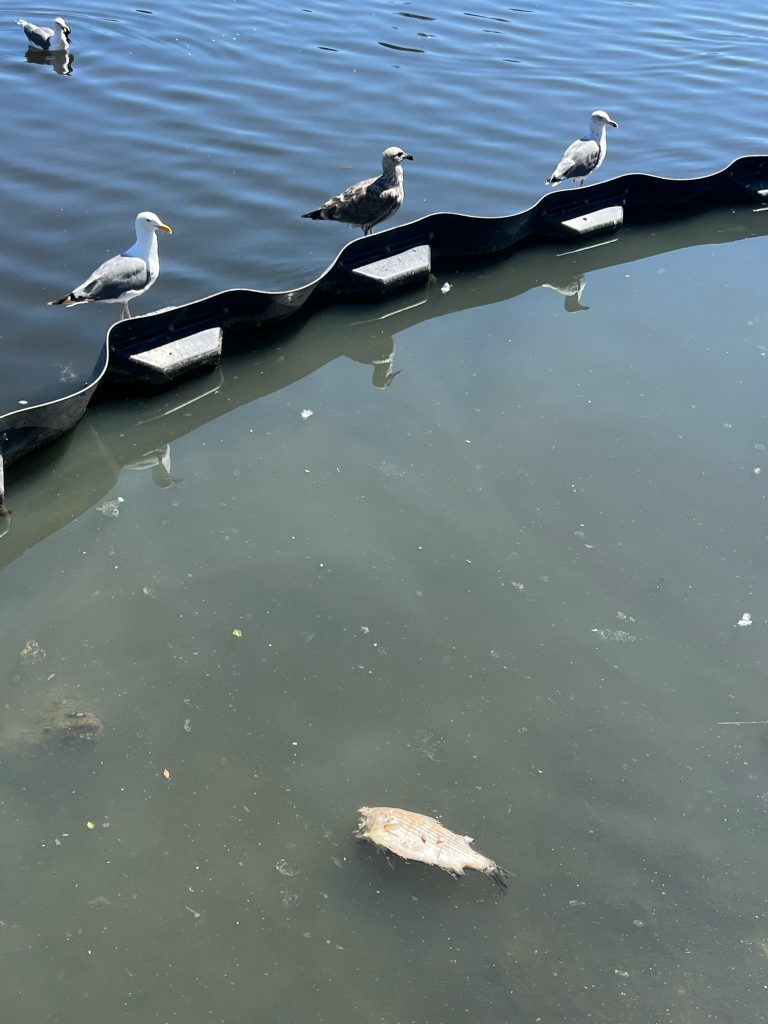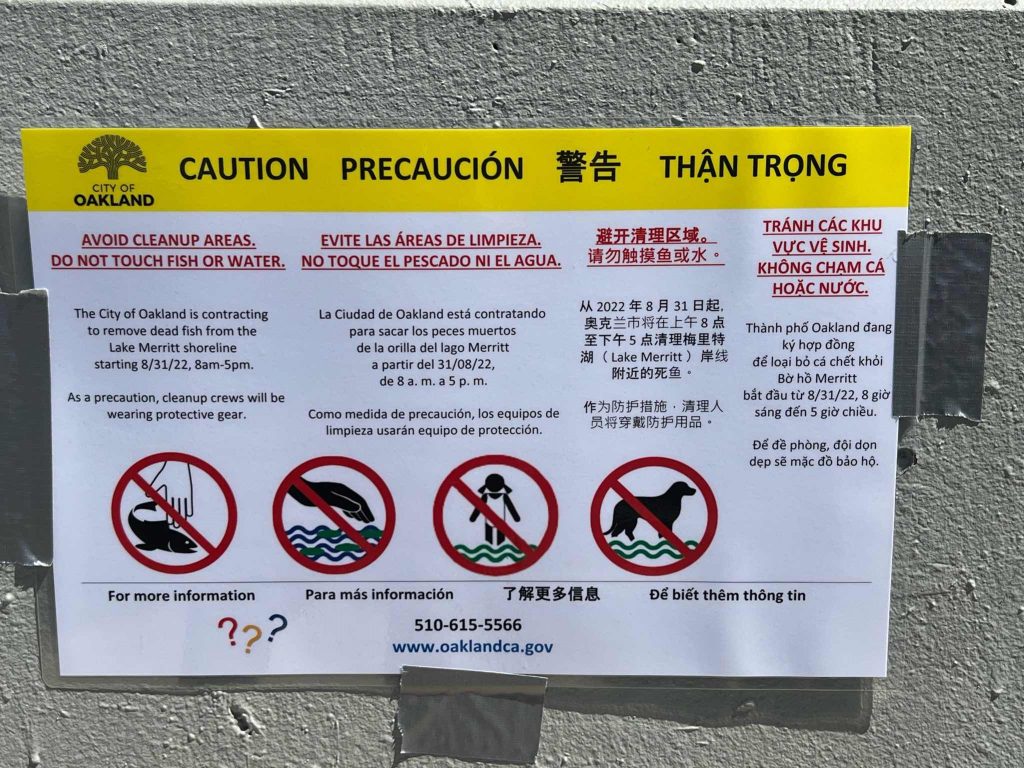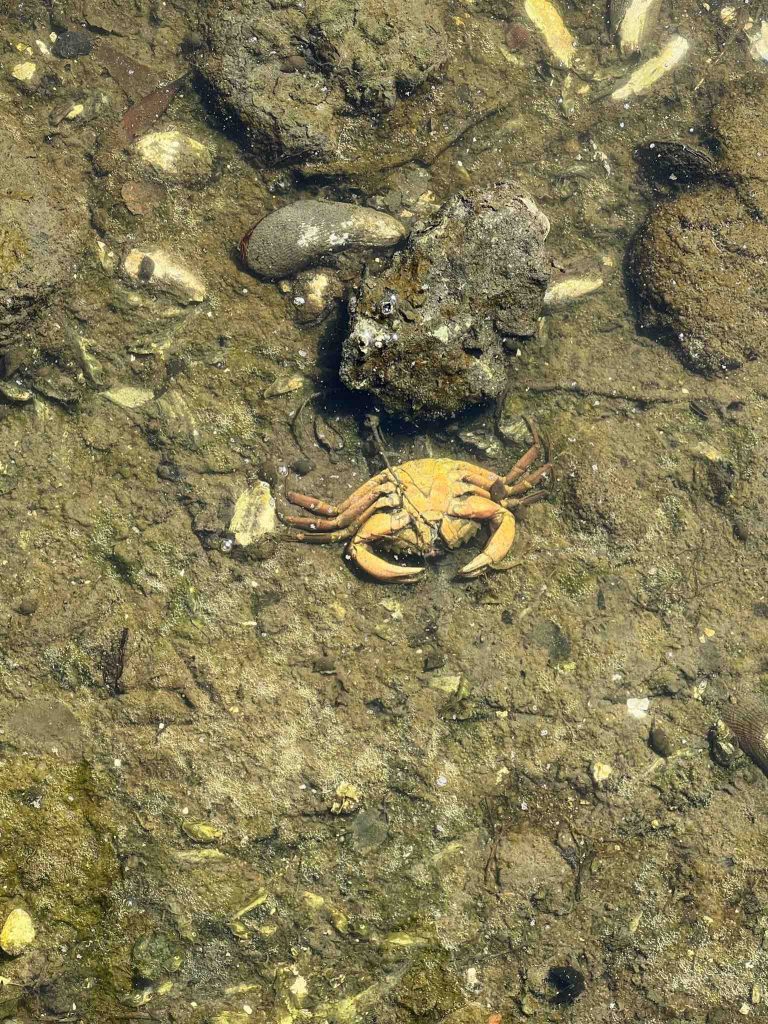“There is a shark washed up at San Quentin Beach” The text came in via our Shark Watch hotline with a picture. The reporter is a young high school student. “It’s still there.”
Reviewing the image, I texted back. “Thank you but I think that is a dead sturgeon. I’ll check it out and forward it to the fish hotline.”
Since early August we have been seeing scores of dead fish washing up on San Francisco Bay beaches from Alameda in the South Bay to Lake Merritt in Oakland, to Sausalito near the Golden Gate. The kill is associated with great bloom of a micro-algae, called a red tide.
In August, thousands of dead fish washed ashore in San Mateo County, from Foster City to Coyote Point. Starting in the SE Bay, reports later spread past Hayward and Alameda Island, in Lake Merritt Oakland, and into the main San Francisco Bay to Fort Baker in Sausalito. Crossing the Richmond-San Rafael Bridge to investigate the report near San Quentin, my polarized sunglasses revealed a distinctly dark swath of water along the tideline stretching from Richmond to the Larkspur channel.

Many of the dead fish washing up are large sturgeon, small sharks, rays, and striped bass, including schools of smaller fish in the water and on shorelines. Extremely hard hit by the die off event was Lake Merritt in Oakland. We visited Lake Merritt, an enclosed tidal lake, where thousands of fish died in mid-August, stacking the shoreline, turning the water brown and fetid with decay. The city of Oakland removed 1200 pounds of stinking sardines, rotting white sea bass and stranded bat rays from the lake’s shoreline on August 30th.
A brackish-water urban lake supplied by the San Francisco Bay, Lake Merritt is enclosed by concrete and also fed fresh water runoff by storm drains from city streets. Provided fresh seawater by only one channel, Lake Merritt is a metaphor for the San Francisco Bay: a small, enclosed shallow body of brackish water with tidal inlet/outlet. Run off from the land, fertilizers, animal and human waste enter the lake, feeding the phytoplankton. Warm water caused by the heat wave, long days of sunlight and the nutrients provided ideal conditions for an algal bloom.
Red Tide
During a red tide, a confluence of environmental factors creates the conditions favorable for a rapid increase in one or more species of planktonic algae. The photosynthetic pigments in the algae create a discoloration giving the water a red, orange or brownish coloration. The subsequent death and decay of the tiny plants remove the oxygen and can contain toxins themselves that lead to the death of fish and other marine life.
This event was created by a species, Heterosigma akashiwo that bloomed beyond control. Normally present in the bay plankton, the small algae responsible are usually prevented from mass increases by strong tides and winds, competition among other species and sediment that reduce sunlight, which the phytoplankton need to grow.
John Rosenfield a senior scientist from Baykeeper, a San Francisco Bay watchdog said that the bay’s high levels of nutrients, mostly phosphorus and nitrogen are discharged from over 40 wastewater treatment plants. Longer days and warmer sea temperatures nurture the plant growth, and nutrients spur the proliferation. These nutrients can exacerbate Harmful Algal Blooms (HAB).
The Bay bloom has been created by a convergence of conditions beyond the microcosm of Lake Merritt. The August heatwave created the meteorological conditions. Routinely, hundreds of millions of gallons of treated sewage discharges into the Bay, but although treated for human waste, the nutrients remain in the discharge. Runoff of untreated street waste and pollutants from industry, including five oil refineries provide the chemical foundations ideal for algal blooms in the Bay at large.
“The San Francisco Bay is one of the most nutrient-polluted water bodies in the nation. This is partly because treated sewage and stormwater from millions of people is discharged directly into the water.” said Rosenfield. The discharge is nutrient-dense, enriched in nitrogen and phosphorus, and warm water temperatures provide the ideal conditions for these bloom events.

The exact mechanism of the recent bloom’s toxicity has not been identified exactly, but gill damage and a lower saturated oxygen in the water that leads to a lack of oxygen (hypoxia) is the proposed cause of fish death. Heterosigma akashiwo can also produce toxic chemicals, but scientists suggest the concentrations of these toxins are too low to account for such a large impact on the fish and invertebrate populations.
The last bloom of Heterosigma akashiwo in the bay was in 2002, and there was also a bloom from a similar species of algae in 2004. The previous blooms also happened around heat waves.
Innocent in normal densities, in large quantities these algae can form Harmful Algal Blooms (HABs), called so because they can be detrimental to the ocean environment and make humans ill. A 1995 article noted that the global distribution of Heterosigma akashiwo is increasing, as is the frequency of HAB formation caused by the algae. Red tides and fish kill are also well known outside the San Francisco Bay and along the coastline, and are monitored by a network of scientists.
A monitoring system called the Southern California Coastal Ocean Observing System (SCCOOS) collects ocean data, records and reports Red Tide events. SCCOOS collects, integrates, and delivers coastal and ocean observations in order to improve safety, enhance the economy, and protect the environment. The SCCOOS reported a bloom off of Santa Barbara and at Newport Beach in April 2022 from Akashiwo sanguinea. This species can be toxic to fish and marine life if concentrations are high enough, and produce skin irritation and illness in humans and pets.
Another event in the spring created a very visible red tide that moved ashore and spread throughout La Jolla Bay and beaches in San Diego. The species responsible for that dark red water is Lingulodinium polyedra. This species is known to bloom frequently along the coast and produces an eerie blue glow at night, in a process called bioluminescence (Greek and Latin for life-light).

When it comes to sharks and rays, the dead found ashore are the tip of the iceberg.
These cartilaginous fish do not have flotation bladders like most bony fish, but must swim or rest on the bottom, and when they die, they sink. The numbers of leopard, smoothhound, and their cousins the bat rays, that wash ashore represent only a small number of the dead.
Other large scale die- offs caused by pathogens have affected fish and sharks in the San Francisco Bay, the most recent killing thousands of Bay sharks in 2017.
Large shark die-offs have been documented in the Bay going back to 1967, when East Bay Regional Park District naturalist Ron Russo (retired) recorded the deaths of more than 725 sharks and rays on the Alameda shoreline over two summer months. More recently, the Santa Cruz based non-profit Pelagic Shark Research Foundation (PSRF) reported large die-offs of sharks in the South Bay between 2002-2006. Following these, the next major event occurred in spring 2011, when PSRF tracked several dozen deaths in Foster City, San Mateo, Sausalito and Mill Valley.

The most recent large scale large shark die-off started in mid-March 2017 concentrated around Foster City and Redwood City, with additional reports from Hayward, Berkeley, Oakland, and San Francisco. The die off was created by a Miamiensis avidus a small single celled organism, identified by California Fish and Wildlife biologist Dr. Mark Okihiro. Infecting the sharks through their nostrils and gills, the parasite attacks the shark’s brain slowly eating away at it causing what we called zombie sharks, swimming aimlessly at the surface until they die and sink.
It is widely accepted by scientists and fisheries managers that high nutrient input creates conditions of algal blooms. The discharge of millions of gallons of nutrient rich water creates ideal conditions in a highly predictable cause and effect, in this case a red tide. Some scientists predict that the bay’s high levels of nutrients, mostly phosphorus and nitrogen discharged from the treatment plants, may bring more harmful algal blooms exacerbated by the impacts from climate change. These events can also impact not just fish, but the health of fish eaters like marine mammals and even humans who consume fish in the Bay.
The Regional Water Quality Control Board (RWQCB) is a state agency charged with protecting beneficial use of the surface, subsurface, recreational and drinking water in California. This agency enforces and guides cities and other agencies in the monitoring, treatment and protection of state waters.
“We’re on it,” she said. “We’re taking action.” Eileen White, the executive officer of the San Francisco Bay Regional Water Quality Control Board, said that the board had spent years working collaboratively with stakeholders to study, monitor and model the impacts of the phosphorus and nitrogen, as well as climate change, on the San Francisco Bay.
The conditions creating these harmful blooms are well understood, and the science is well established. The San Francisco Estuary Institute (SEFI), composed of scientists and state partners has monitored, studied and produced recommendations on nutrient management in the Bay, publishing several reports including the San Francisco Bay Nutrient Management Strategy. This program is a regional initiative for developing the science needed for informed decisions about managing nutrient loads and maintaining beneficial uses within the Bay in response to the apparent changes in the Bay’s resilience to nutrient loading.

The Regional Water Board, the Association of Bay Area Governments and the 7 Cities must work harder to reduce excessive nutrients and keep refinery discharges under control. To protect the health of the Bay wildlife, the cities need to invest in water recycling to keep these nutrients out of the Bay.
With predictions of the heat wave exacerbating more fish deaths, we returned to Lake Merritt over the Labor Day weekend. Walking the shoreline we see clumps of dead anchovies, random decaying white seabass, dead crabs and clams stinking in the mud, but nothing like the previous piles of dead fish hauled off by Oakland Public Works and volunteers. With hope, the 2022 Harmful Algal Bloom die-off is over, but the potential for another lies ahead.
The time for study is well past and the time to “get on it” is now, before another visible and invisible plague affects Bay wildlife, and we suffer another large scale die-off. The public can help by collecting data on the SEFI pollution hotline or fish kill reporting form if you notice a large quantity of dead fish near shoreline areas. If the public sees a shark, live, dead or on the hook, the Shark Watch CA program records observations of California sharks and rays.
SOURCES
Rensel, J. E. (2007). “Fish Kills from the harmful alga Heterosigma akashiwo in Puget Sound: recent blooms and review”. National Oceanographic and Atmospheric Administration Technical Report.
Anderson, Donald M. (July 1995). “Toxic red tides and harmful algal blooms: A practical challenge in coastal oceanography”. Reviews of Geophysics. 33 (S2): 1189–1200. Bibcode:1995RvGeo..33S1189A. doi:10.1029/95RG00440.
Keppler, Charles J. (2005). “Sublethal effects of the toxic alga Heterosigma akashiwo on the southeastern oyster (Crassostrea virginica)” (PDF). Harmful Algae. 4 (2): 275–285. doi:10.1016/j.hal.2004.05.002.
Mark L. Wells, Bengt Karlson, Angela Wulff, Raphael Kudela, Charles Trick, Valentina Asnaghi, Elisa Berdalet, William Cochlan, Keith Davidson, Maarten De Rijcke, Stephanie Dutkiewicz, Gustaaf Hallegraeff, Kevin J. Flynn, Catherine Legrand, Hans Paerl, Joe Silke, Sanna Suikkanen, Peter Thompson, Vera L. Trainer,
Future HAB science: Directions and challenges in a changing climate,
Harmful Algae, Volume 91, 2020,
(https://www.sciencedirect.com/science/article/pii/S156898831930099X)
Cloern, J.E., Schraga, T.S., Nejad, E. et al. Nutrient Status of San Francisco Bay and Its Management Implications. Estuaries and Coasts 43, 1299–1317 (2020). https://doi.org/10.1007/s12237-020-00737-w
RMP Regional Monitoring Program for Water Quality in San Francisco Bay MULTI-YEAR PLAN 2022 ANNUAL UPDATE San Francisco Estuary Institute, March 2022, sfei.org/rmp